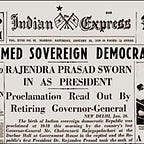The National Identity VIII: The Battle of Asal Uttar and the Legacy of the ’65 War
In the current nuclear rhetoric between India and Pakistan, it is difficult to imagine a time when the conversation centered around conventional forces. It is even harder to conceive that India once had the inferior conventional strength. What isn’t hard to imagine is that Pakistan assiduously tried all the tricks in the bag to cut Kashmir off from the rest of India – including cutting off territory west of the river Beas, i.e. Amritsar. This is the story of the heroic stand put up by the Indian Army in the 1965 War in the Khem Karan sector in Punjab and the story of the largest tank battle since World War II – The Battle of Asal Uttar, and the lessons never learned.
Pakistan’s ruler, General Ayub Khan, sensed a great opportunity in 1965 – the Indian Army was still coming to terms with the devastating loss in the war against China in 1962, the morale of the armed forces was at its’ nadir and Pakistan had superior, American supplied, machinery and Jawaharlal Nehru was succeeded by a “weak” leader in Lal Bahadur Shastri. Thus Operation Gibraltar and Grand Slam were born.
“Indians know how to die for their country but not to win for their country” – Field Marshal Bernard Law Montgomery, in the History of…
